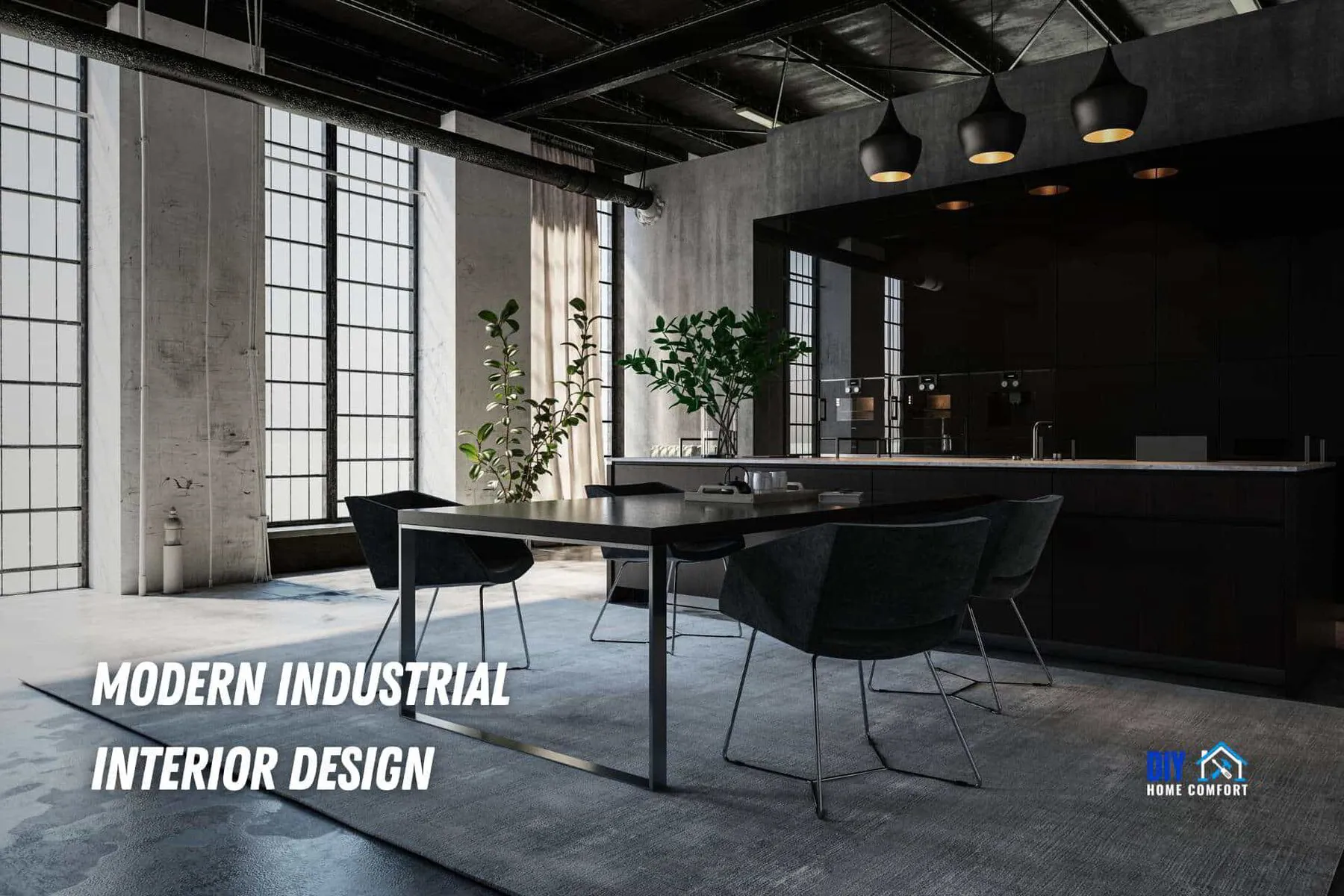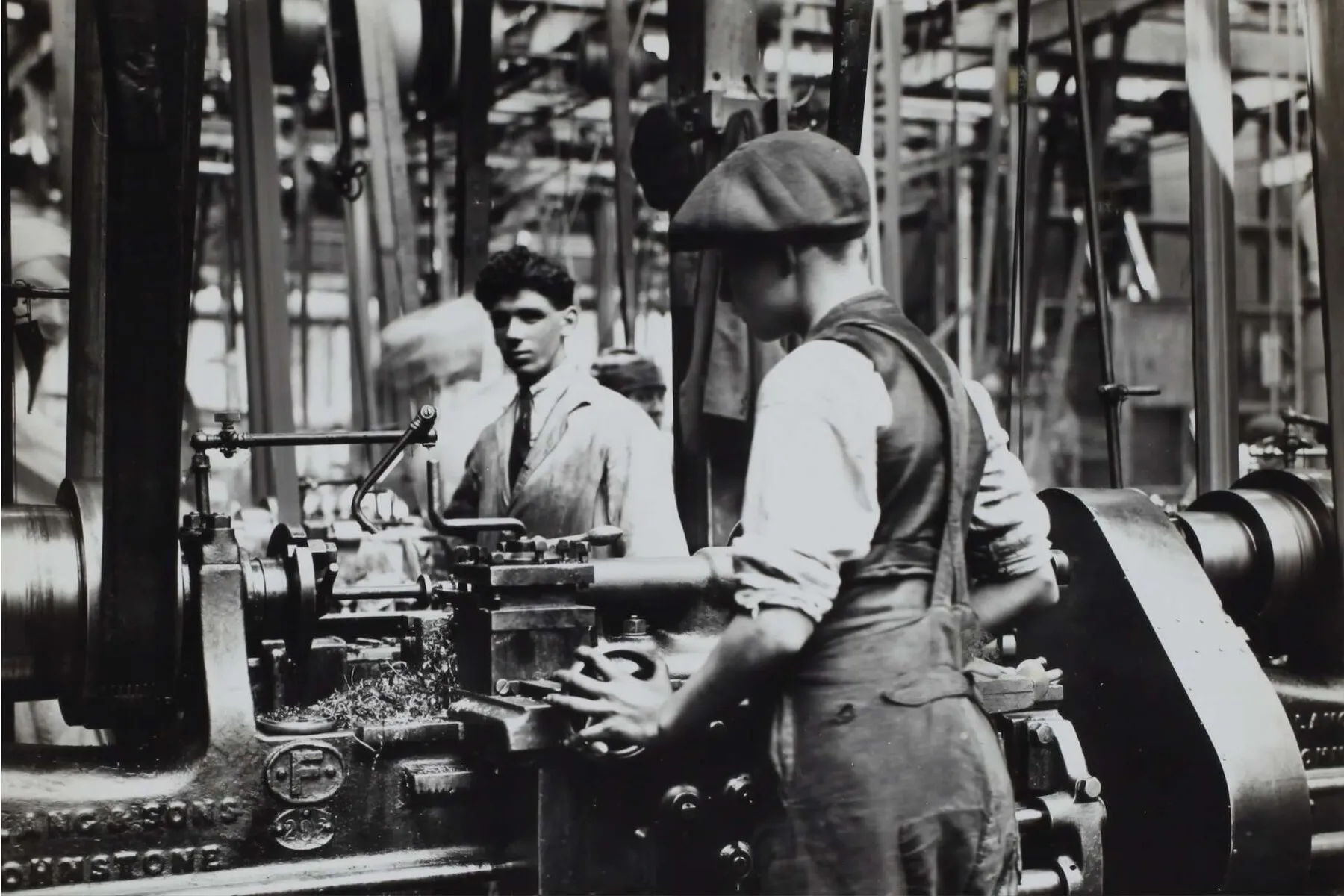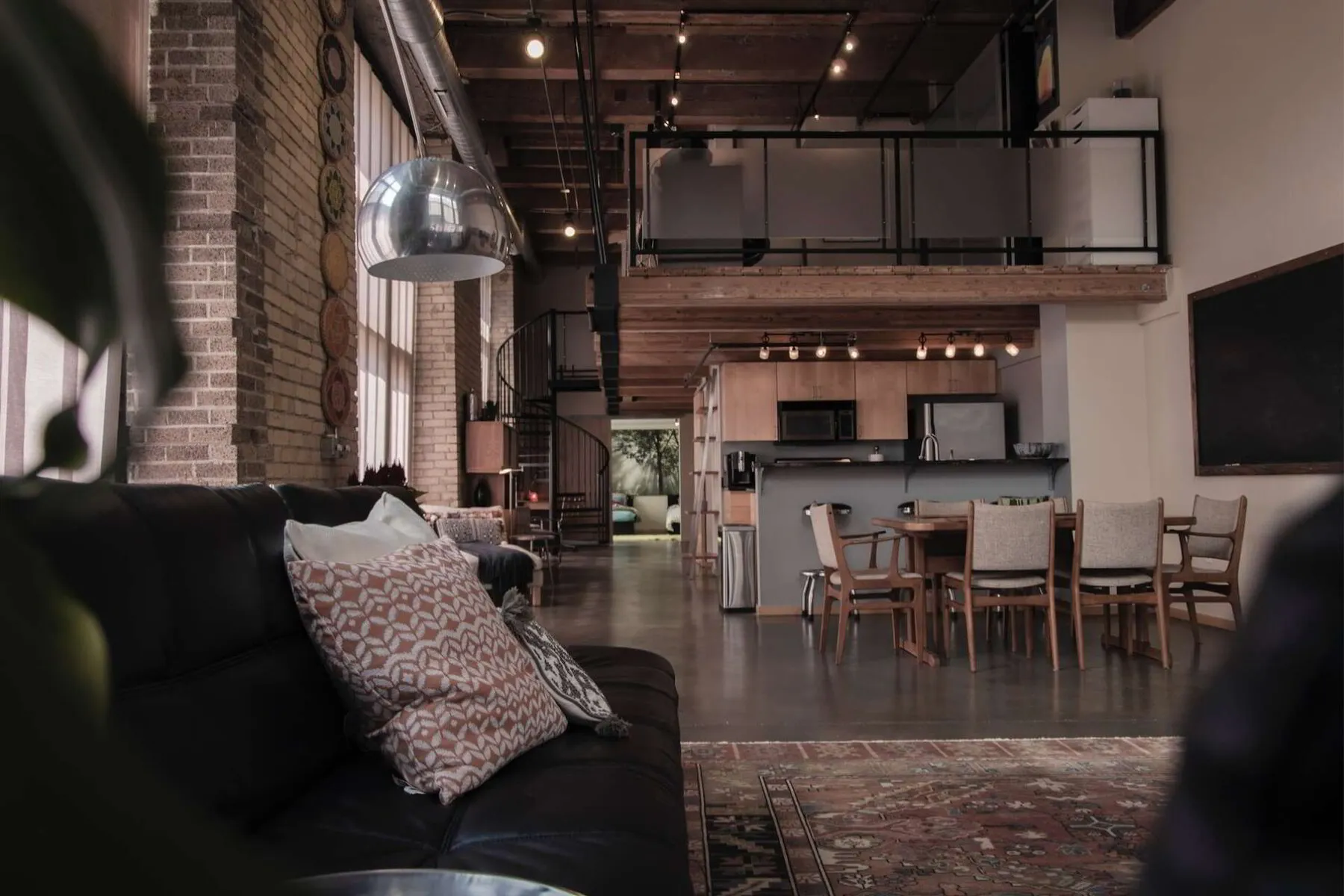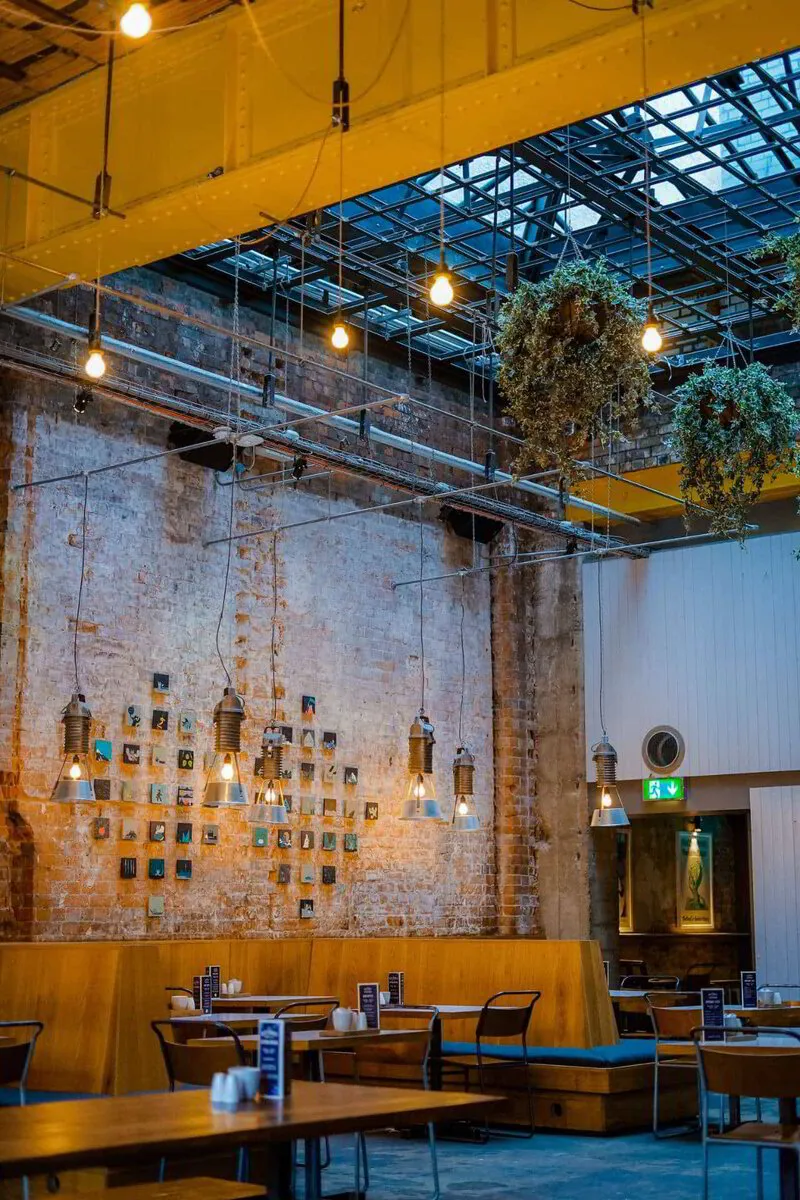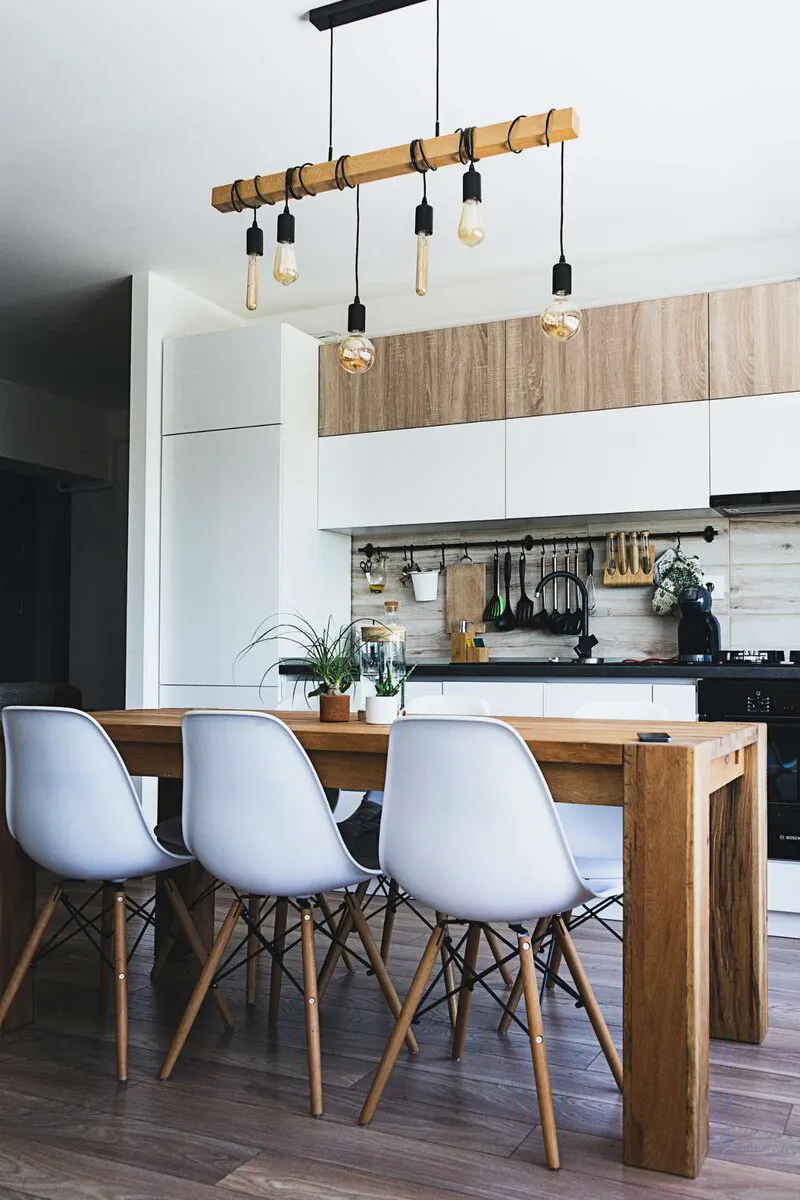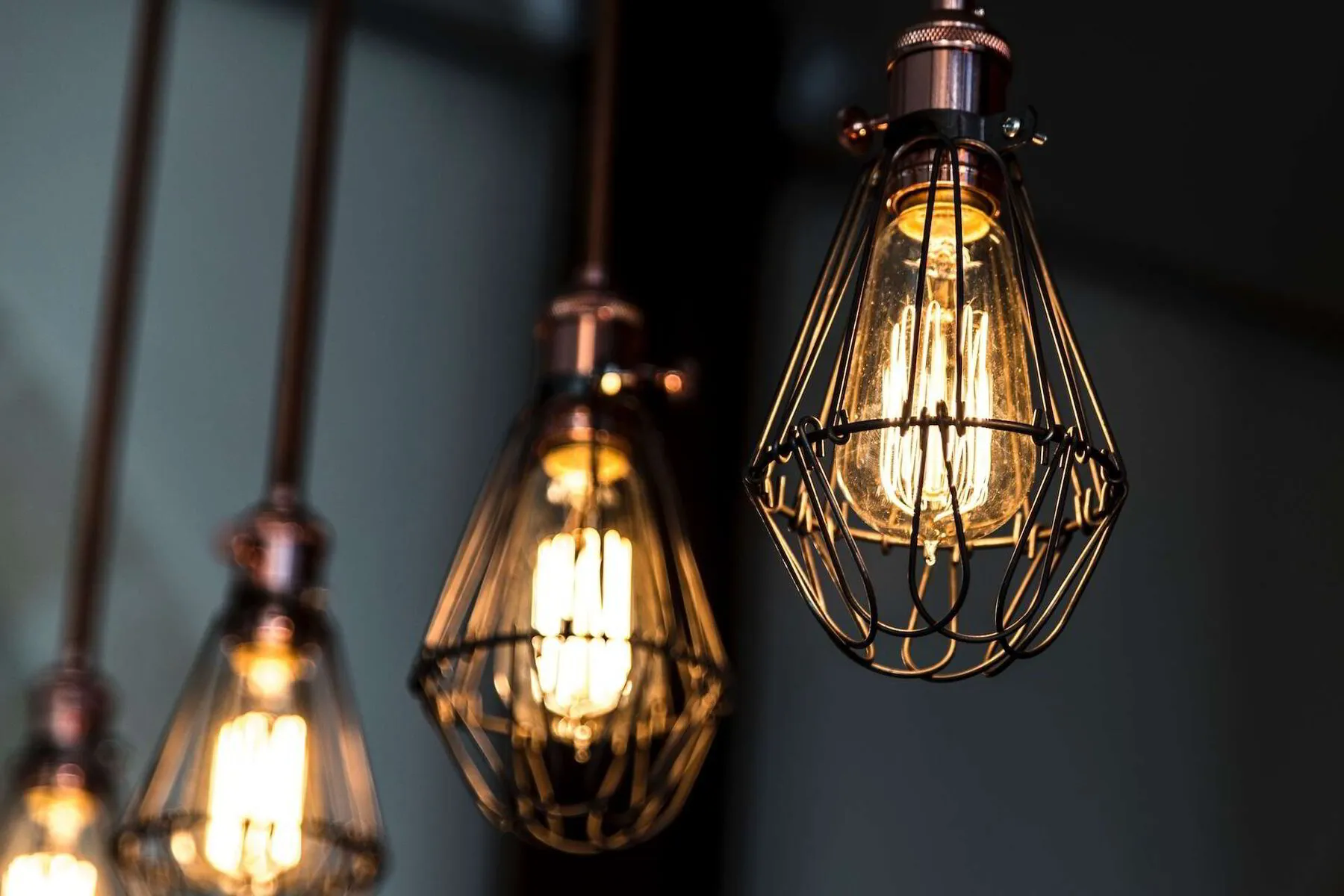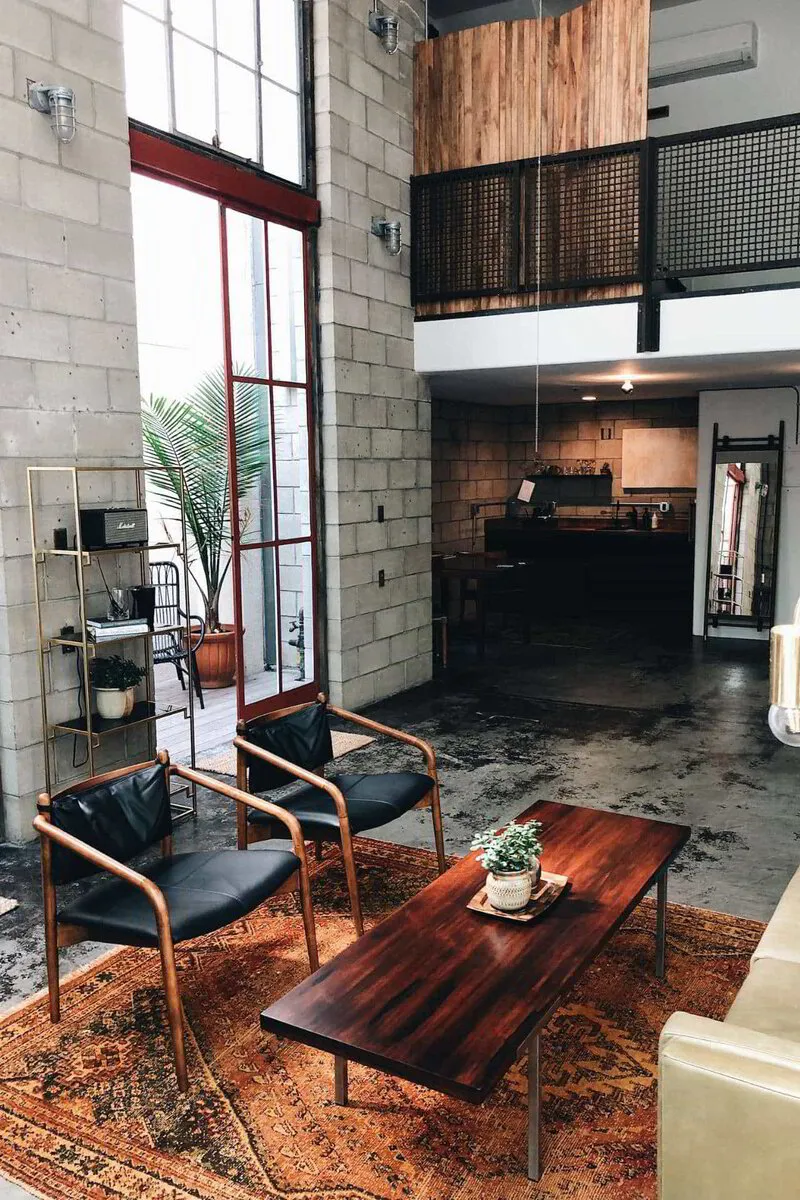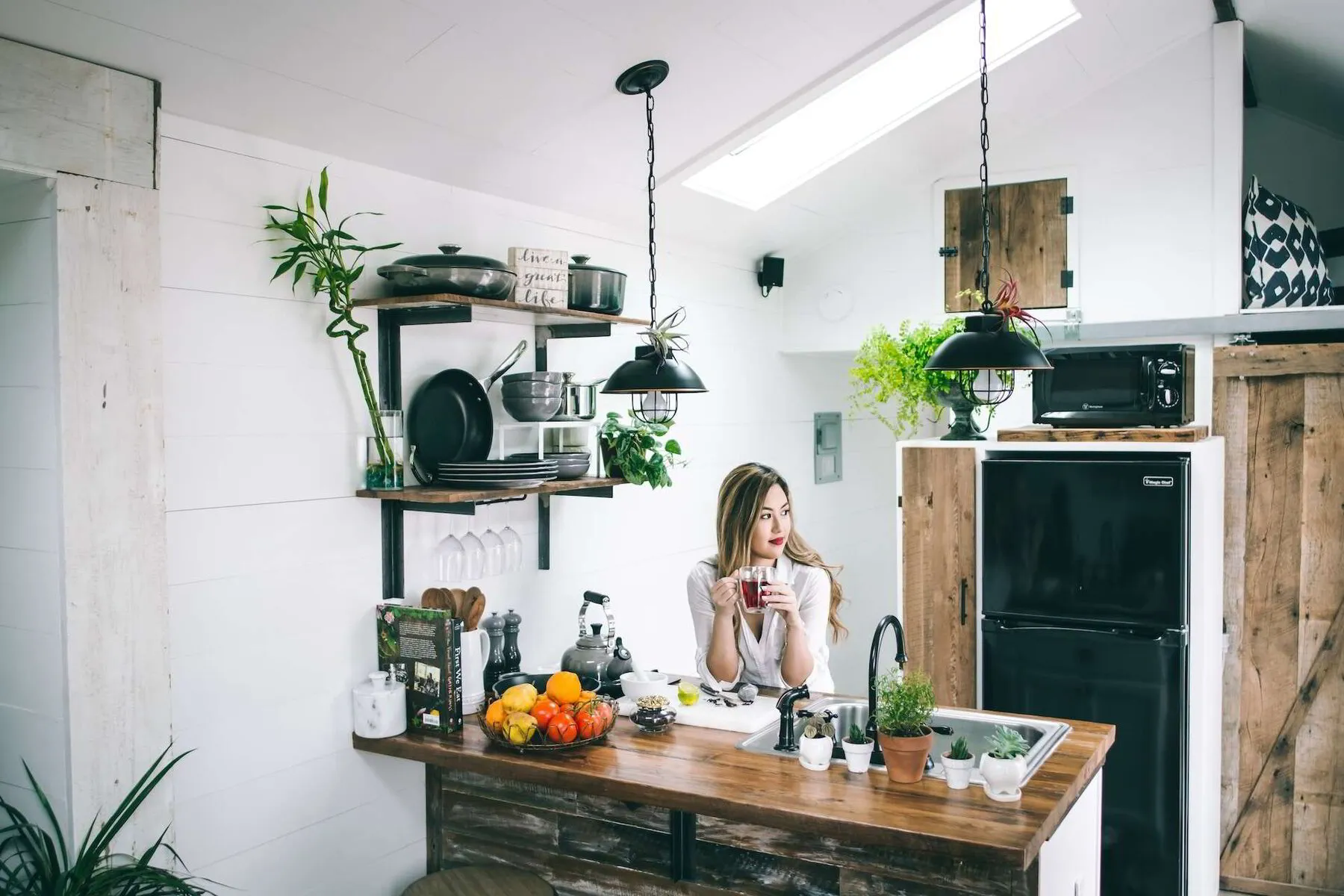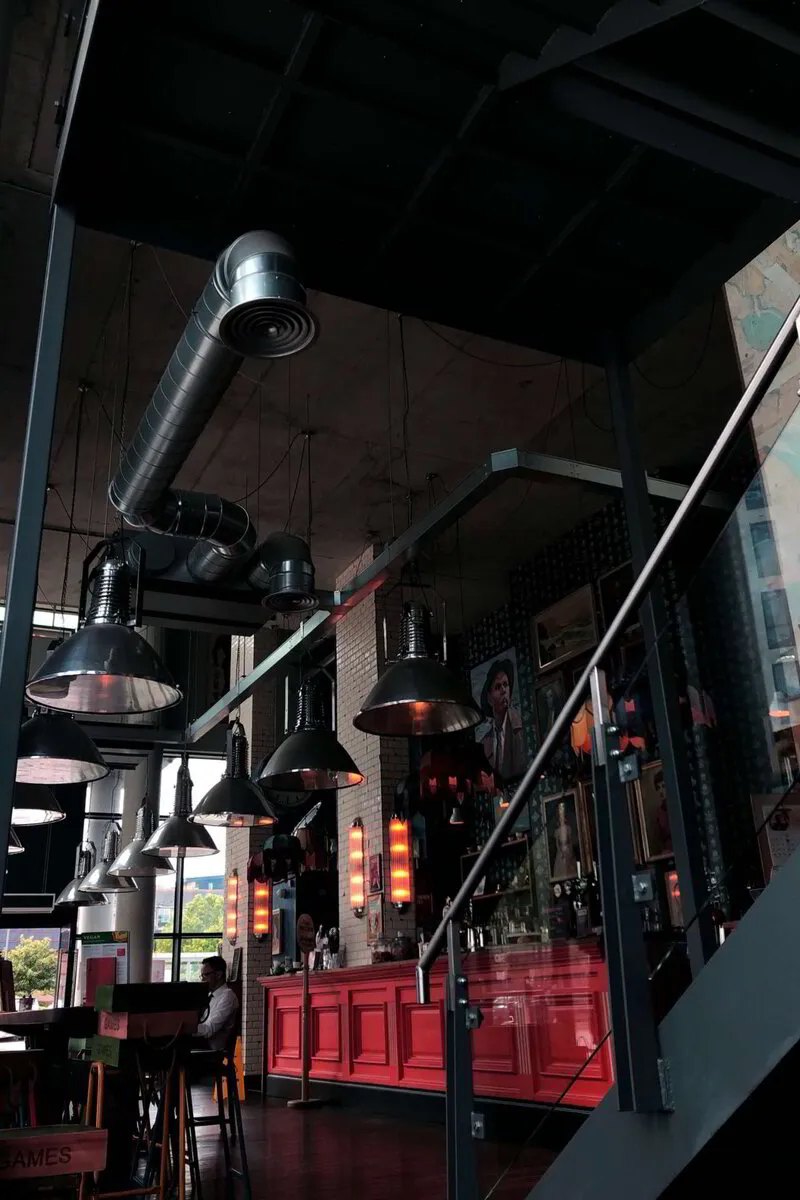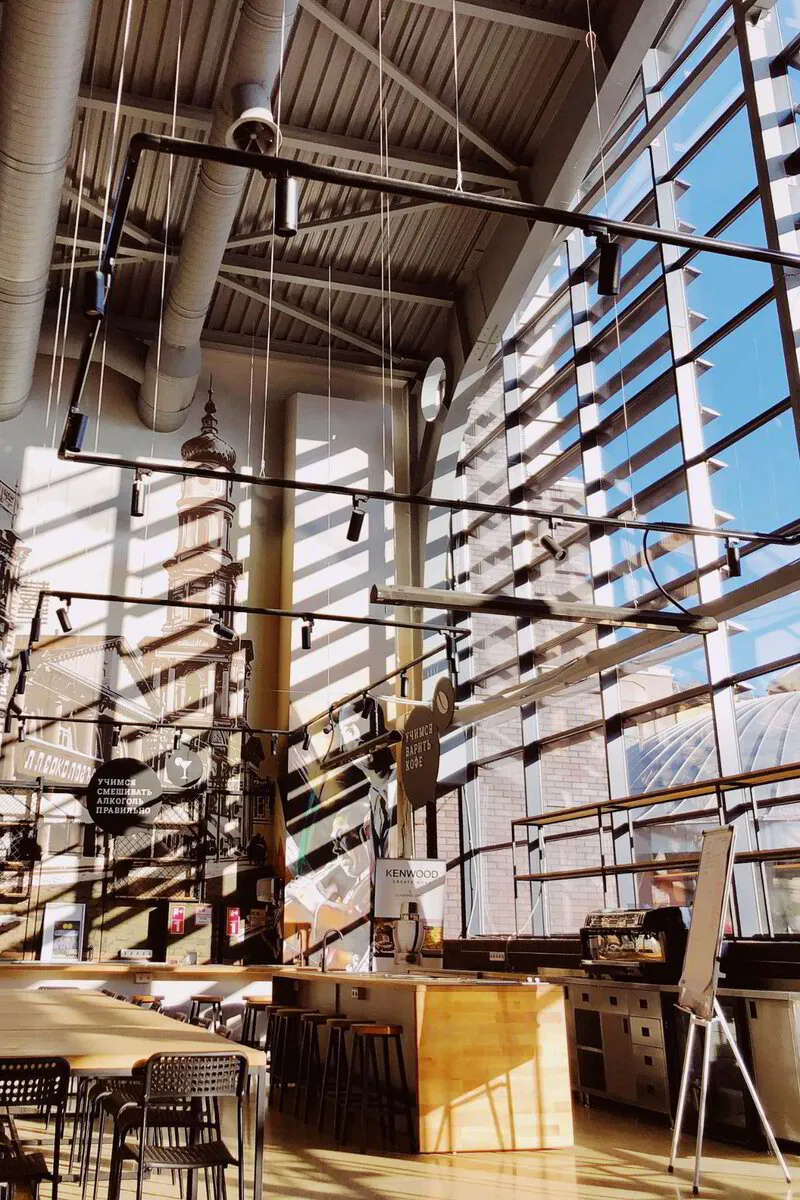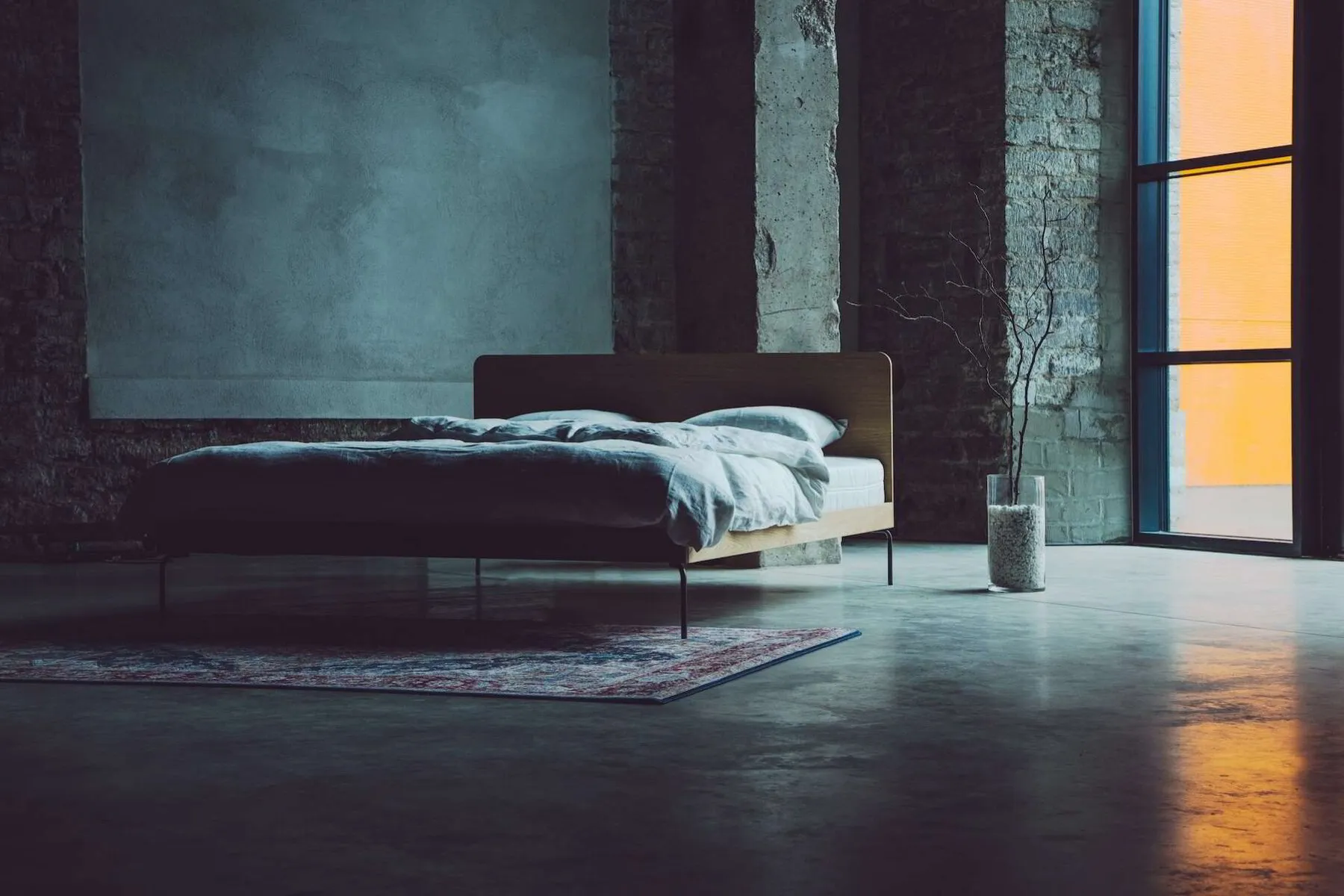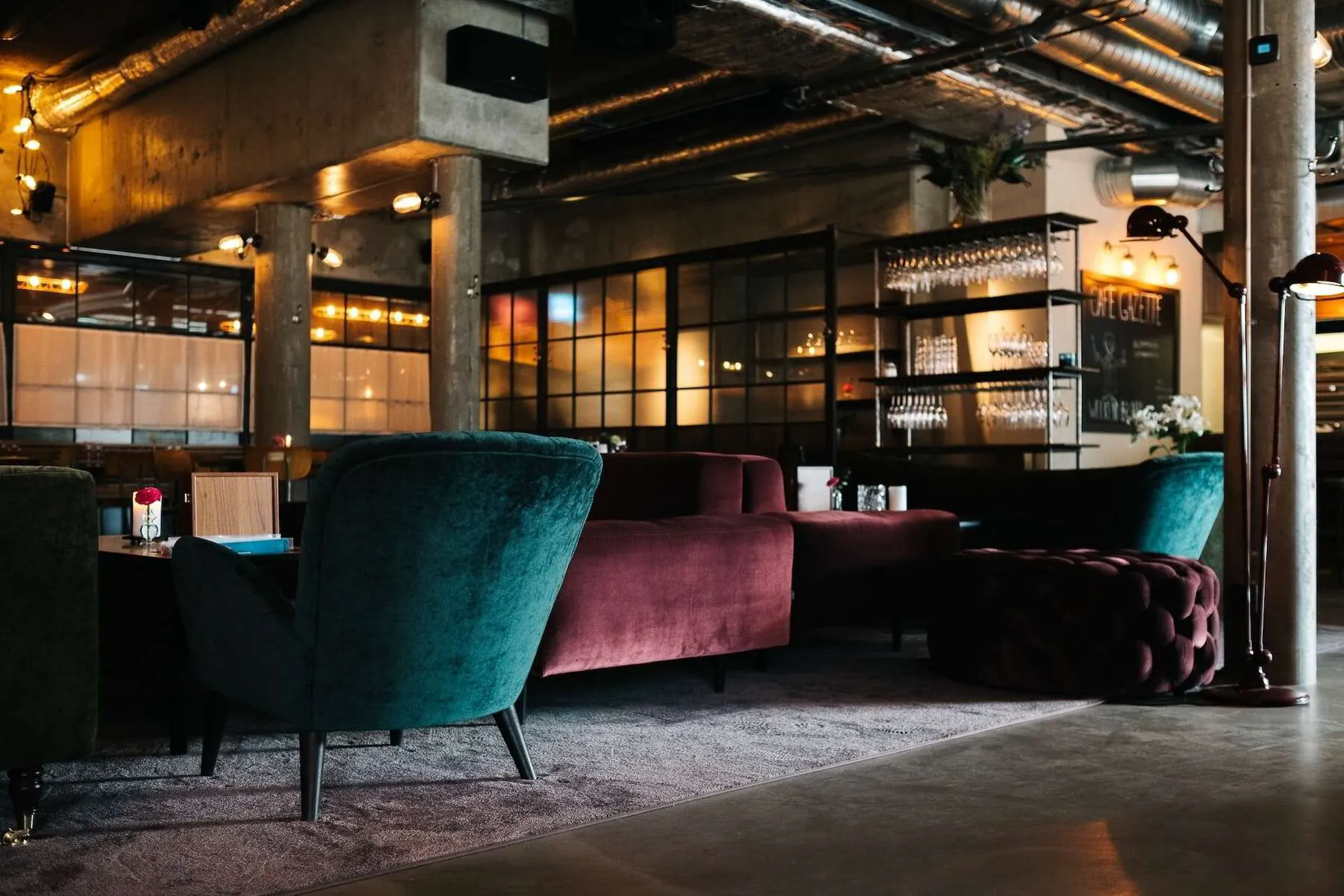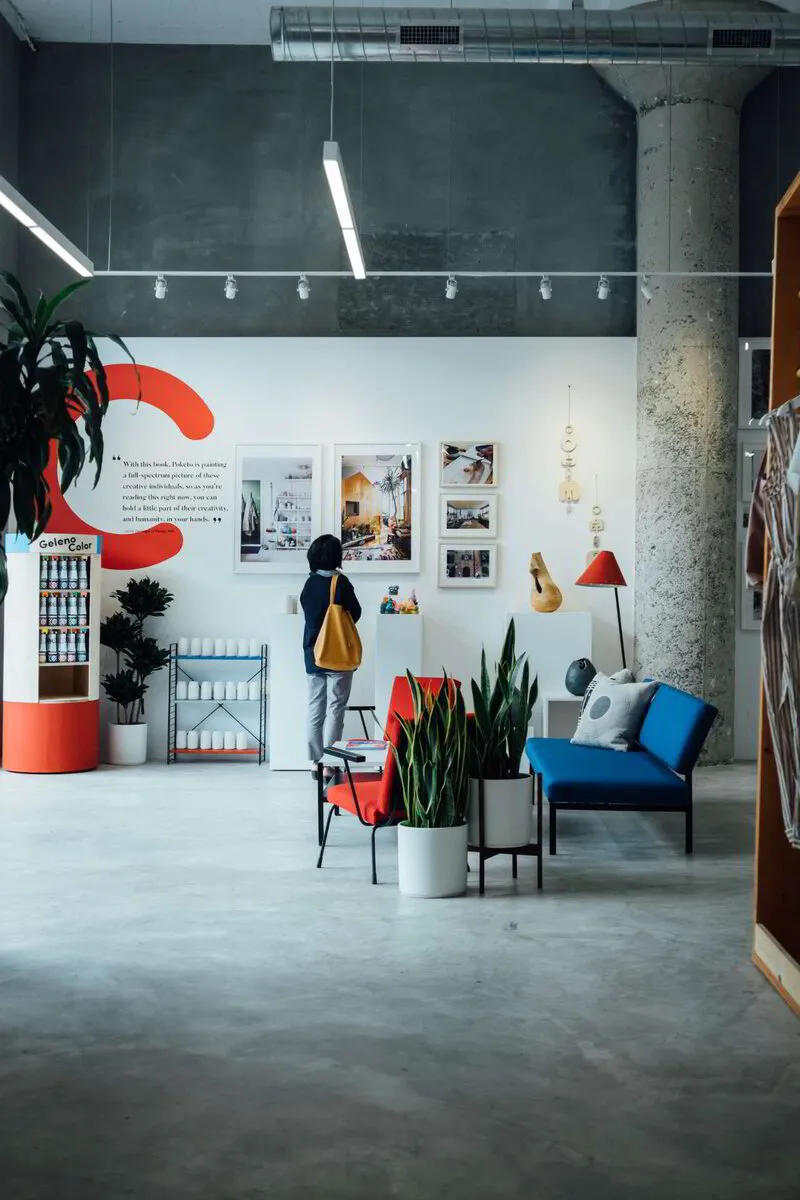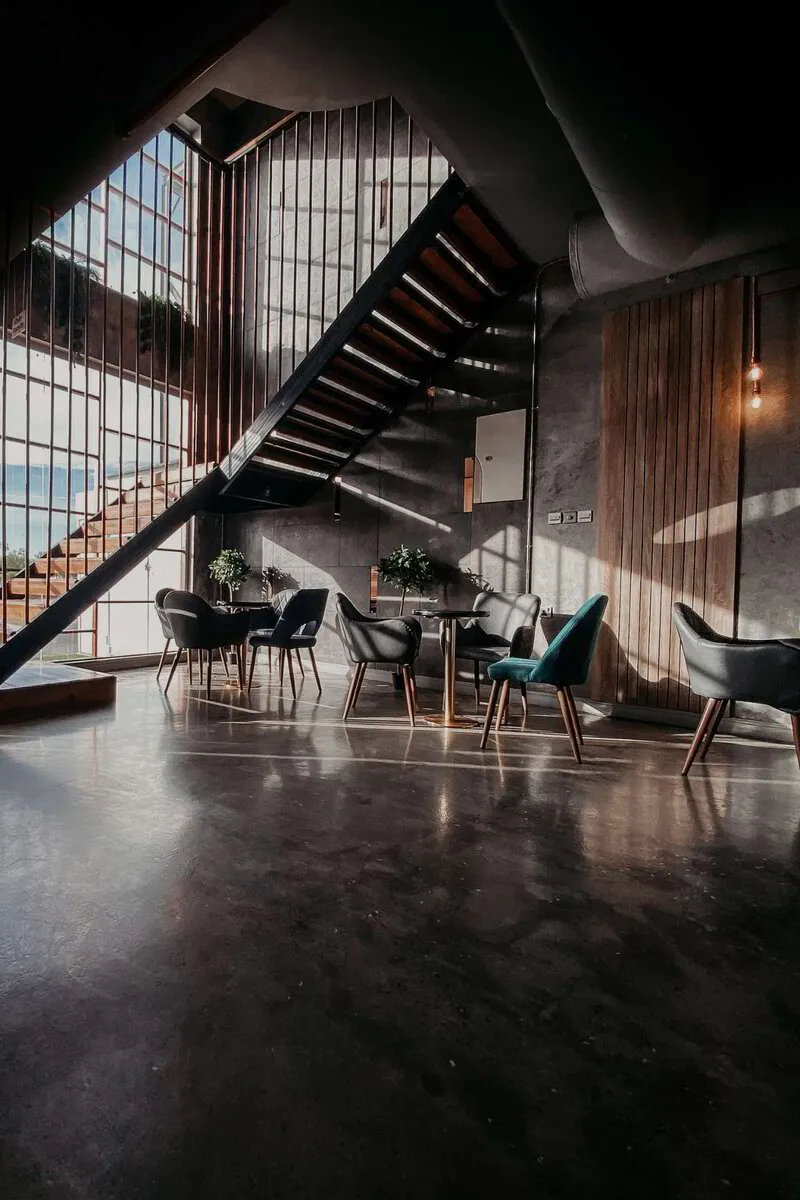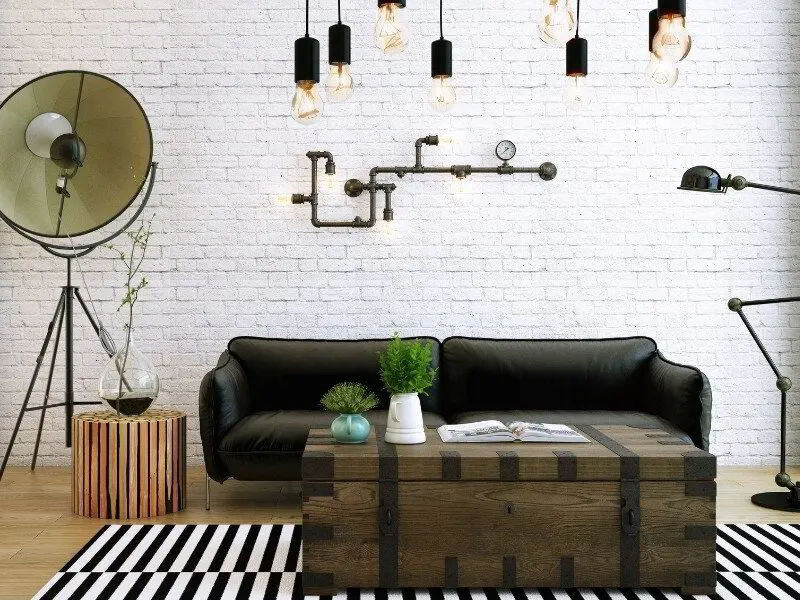Welcome to another exciting journey into the world of interior design.
Today, we're diving deep into a style that's been making waves in the design world - Modern Industrial Interior Design.
You might think, "Isn't industrial design all about cold metals and harsh lines?" Well, prepare to have your perceptions turned on their head! Modern industrial interior design is truly the perfect blend of old and new.
It's about taking raw, gritty elements from industrial spaces and blending them with modern, comfortable features to create a stylish but also a warm and inviting home.
Think exposed brick walls paired with plush, cozy sofas. Imagine sleek metal accents alongside rustic wooden tables. Picture vast, open spaces filled with natural light, dotted with personal touches that make it feel like home—intrigued yet?
In this comprehensive guide, we'll walk you through everything you need to know about this unique interior style. From its history and critical elements to tips on incorporating it into your own space, we've got you covered.
So, please grab a cup of coffee, get comfy, and let's explore the captivating world of Modern Industrial Design together!
Remember, every home tells a story, and with a bit of creativity and DIY spirit, you can make yours a bestseller. Let's get started!
📘 Key Takeaways
- Definition: Modern industrial interior design is a fusion of raw, gritty industrial elements with modern, comfortable features.
- Origins: The style traces its roots to the Industrial Revolution and gained popularity in the 1960s and 70s when old factories were converted into living spaces.
- Characteristics: Key features include exposed brick walls, sleek metal accents, open spaces with natural light, and a neutral color palette.
- Modern vs. Traditional: While traditional industrial design celebrates raw architectural elements, modern industrial design introduces more contemporary features and a polished look.
- Design Ideas: Embrace neutrals, combine modern and rustic elements, focus on architectural details, and consider innovative storage solutions.
- Conclusion: Modern industrial interior design is about striking a balance between aesthetics, practicality, and sustainability.
What is Industrial Interior Design?
Industrial interior design is a popular design style that draws inspiration from old factories and industrial spaces. Characterized by raw textures and utilitarian features, it seamlessly blends the rough with the refined.
Key elements of this style include exposed brick walls, metal accents, wood beams, and open floor plans. The color palette tends to be neutral, often featuring shades of grey, black, white, and brown.
Industrial interior design embraces the concept of minimalism and functionality, often incorporating repurposed or salvaged items for an authentic, unfinished look.
It's a style that celebrates the beauty in simplicity and the charm of the aged and weathered, creating a space that feels both sophisticated and lived-in.
Origins and History of Industrial Interior Design
Industrial interior design is rooted in the Industrial Revolution of the early to mid-20th century when urban landscapes were rapidly changing due to industrialization.
As factories and warehouses were abandoned or relocated, these large, open spaces were left empty. In the 1960s and 70s, artists and creatives began to see potential in these derelict spaces.
They started converting these old factories and warehouses into living and working spaces, creating what we now know as loft apartments.
These spaces retained the original industrial elements, such as exposed bricks, beams, ductwork, and metal fixtures.
This was not just a design choice but also a practical one, as it was often cheaper to leave these elements exposed than to cover or remove them.
This aesthetic, which embraced these spaces' raw, unfinished look, was the beginning of the industrial interior design trend. Over time, this industrial style interior design has evolved.
It has been adapted for more conventional homes, but it still retains its core principles: simplicity, functionality, and an appreciation for the raw beauty of industrial materials.
The industrial design style is celebrated for its visual appeal and ability to create a sense of space and light. It's a style that celebrates the past while looking forward to the future, making it a timeless choice for modern interiors.
Characteristics of Industrial Interior Design
Industrial interior design is known for its unique aesthetic that focuses on raw, utilitarian, and architectural elements.
Here are the top characteristics of industrial interiors:
Exposed Architectural Materials: This design style often reveals the building's original architectural elements like bricks, concrete, steel beams, pipes, and ductwork. Instead of hiding these features, they are celebrated and made a part of the interior design.
Open Spaces: Industrial interior design typically for industrial space includes open floor plans with high ceilings, often featuring a wealth of windows and natural light. The layout is often spacious and airy, adding to the warehouse-inspired aesthetic.
Neutral Color Palette: The color palette leans towards neutral shades and tints. Blacks, grays, browns, and whites are neutral tones that are commonly used in industrial design, creating a sense of simplicity and rawness.
Raw and Rough Textures: Industrial design is all about achieving a raw, edgy style that looks unfinished yet cohesive. It embraces rough textures like weathered and distressed wood, rusted metal, and exposed brick.
Metal and Wood Furniture: The furniture used in industrial interior design often combines metal and wood, adding to the overall raw and rustic look of industrial decor. This can include items like metal shelving units, wooden tables, and leather seating.
Concrete Flooring: Concrete floors are a staple in industrial design. They are durable practical, and add to the raw, unfinished aesthetic of the space.
Bare Windows: To allow for plenty of natural light, windows are often left bare without curtains or blinds. This not only maximizes light but also adds to the minimalistic, raw look of the space.
What's the Difference Between Industrial Design and Modern Industrial Design?
Yes, there is a difference between industrial interior design and modern industrial design.
Industrial interior design is characterized by its celebration of raw architectural elements such as exposed bricks, metals, concrete, and timber, often inspired by old factories and industrial spaces. This design style typically includes open floor plans, high ceilings, and utilitarian objects.
The color palette of industrial design elements leans towards neutral shades like blacks, grays, and whites.
On the other hand, modern industrial design is a blend of the industrial design aesthetic with a modern twist. While it retains key elements of industrial design, like the stripped-back architecture and raw materials, it also incorporates more contemporary elements.
This could include cleaner lines, modern furniture styles, and sometimes even a bit of minimalism.
Modern industrial style might also be a bit more refined than traditional industrial design, with a balance between rawness and sophistication. It's common to see a mixture of old and new in this style, combining weathered surfaces with modern conveniences
While both styles share an appreciation for raw and architectural elements of industrial buildings, the modern industrial style introduces more contemporary features and a slightly more polished look.
15 Best Industrial Interior Design Ideas
1. Embrace the Power of Neutrals
Neutral shades, primarily blacks, grays, and browns, form the foundation of this industrial-style interiors. Use earthy tones like tan and brown for a calming look or black for an elegant touch.
While white is less common in industrial design, it can add a refreshing twist.
The key is to balance and blend various neutral shades and textures to achieve a harmonious and sophisticated ambiance.
Real World Application:
To effectively incorporate neutrals, start by choosing a neutral shade for large surfaces like walls, floors, and main furniture pieces.
This creates a calming and cohesive backdrop. Layer different neutral tones through textiles like rugs, cushions, and curtains to add depth and texture.
Introduce natural materials like wood, stone, and leather to enhance the warmth and richness of the space.
Lastly, accentuate with metallic finishes in gold, silver, or bronze for a touch of elegance.
2. Raw Textures and Patterns: Enhance Your Space's Tactile Appeal
Infuse your industrial makeover with a bit of drama by embracing raw materials.
Picture this: an exposed brick wall adding a rustic touch, patterned cement tiles creating a captivating visual, or textured wallpaper providing depth and intrigue.
These tactile elements make your space feel more authentic and invite a sense of warmth and coziness.
Real World Application:
To enhance tactile appeal in interior spaces, integrate natural elements like exposed brick walls, rough-hewn wood, and unrefined stone surfaces.
Pair these with textiles that offer a tactile sensation, such as jute rugs, linen curtains, and woolen throws. Incorporate handcrafted decor pieces, like woven baskets or artisanal pottery, to add depth and character.
3. Combining Modern and Rustic Elements
Mixing modern and rustic elements can breathe life into your home decor.
Start by pairing sleek, contemporary furniture with rustic, weathered pieces for a balanced look. Incorporate industrial materials like metal and concrete alongside natural elements like wood and stone.
Add vintage accents for a touch of charm.
This blend of old and new creates a unique, inviting, stylish, and comfortable aesthetic.
Real World Application:
To seamlessly merge modern and rustic elements, start by pairing sleek, contemporary furniture with rustic materials like reclaimed wood or distressed leather.
Introduce modern lighting fixtures alongside vintage or antique decor pieces.
Use clean lines and neutral colors from the modern palette, then add warmth with rustic textures and natural fabrics.
This fusion creates a harmonious space that exudes both the charm of yesteryears and the sophistication of contemporary design.
4. Maintain the Magic of Open Spaces
Open spaces are a magic wand for your home. They create an illusion of more room, boosting comfort and freedom.
To maintain this magic, avoid clutter. Opt for minimalist furniture and smart storage.
Use light colors to enhance the open feel and strategically place mirrors to reflect light.
Remember, open space isn't just about size; it's about creating a welcoming, breathable environment. Time to wave that wand and let the magic unfold!
Real World Application:
To maintain the magic of open spaces, opt for a minimalist approach with fewer, well-chosen furnishings.
Use transparent or low-profile furniture to avoid obstructing sightlines. Incorporate multi-functional pieces that save space and declutter.
Employ a cohesive color palette to unify different areas, and use area rugs or lighting to subtly define zones without erecting walls. This approach ensures a spacious feel while retaining functionality and style.
5. Illuminate Your Space with Industrial Charm
Incorporate statement industrial lighting like pendant lights or vintage Edison bulbs. They illuminate your space and add a raw, vintage vibe. Opt for metallic finishes or exposed wiring to keep it edgy.
Remember, lighting is not just functional; it's a key decorative element. So, switch on the industrial charm and watch your home glow with personality.
Real World Application:
To illuminate your space with industrial allure, integrate pendant lights with exposed bulbs, metal cage designs, or aged bronze finishes.
Use track lighting or wall-mounted fixtures with a raw metal look for a warehouse-inspired vibe.
Reclaimed or repurposed lighting elements, like old factory lamps or pulley systems, can add authenticity.
Pair these fixtures with dimmable bulbs to balance the ruggedness with a warm, cozy ambiance. This lighting approach casts an industrial glow, enhancing the room's character.
6. Loft Windows: A Modern Industrial Must-Have
Loft windows are a game-changer in the world of modern industrial home design. They pour in a ton of natural light, making your space feel bigger and brighter.
Their sleek design complements any decor, adding an urban chic vibe to your home. Whether you prefer those grand, floor-to-ceiling windows or smaller ones, loft windows will level up your space.
Real World Application:
To integrate them, opt for black-framed windows to accentuate the industrial vibe. Leave them bare or use sheer curtains to maximize natural light while maintaining privacy.
If installing new windows isn't feasible, mimic the look with large mirrors framed in black metal. These windows or their illusions not only brighten the space but also enhance the expansive feel of industrial design.
7. Eco-Friendly Choices for a Greener Home
Ready to give your industrial-style home a green makeover? It's easier than you think! Start by incorporating reclaimed wood furniture, installing energy-efficient loft windows, or using low-VOC paints.
Opt for LED lighting in your exposed light fixtures - it is eco-friendly and complements the modern industrial aesthetic.
From recycling old materials to choosing sustainable ones, every little step makes a big difference!
Real World Application:
For a greener home, prioritize sustainable materials like reclaimed wood, recycled metal, or bamboo.
Opt for energy-efficient lighting and appliances. Incorporate indoor plants for natural air purification and aesthetics. Use non-toxic paints and finishes to maintain indoor air quality.
Choose furniture and decor from local artisans or brands committed to sustainable practices.
8. Unleash the Bold Appeal of Metal Elements
Metal elements are a key component of industrial design. Incorporating iron shelf brackets or stainless steel furniture can instantly transform your space.
A metal pendant light creates a striking focal point, while a copper coffee table adds a rustic touch. To avoid harshness, balance these metallic accents with softer materials.
Get ready to weave some metallic magic into your home!
Real World Application:
To infuse the bold charm of metal into your decor, integrate metal shelving, tables with iron bases, or chairs with steel legs.
Use metallic finishes in fixtures, from faucets to light pendants. Accent walls with metal art pieces or industrial gears. Opt for metal stair railings or room dividers with metal grids.
These elements, whether matte, polished, or distressed, add a raw industrial edge, enhancing the room's character and strength.
9. Reveal the Architectural Backbone of Your Home
Uncovering the architectural backbone of your home can significantly enhance your industrial design makeover.
Expose brick walls, wooden beams, or concrete floors to reveal the raw beauty of your home. This approach emphasizes authenticity and adds a unique character to your space.
Pair these features with minimalist decor to let the architectural elements shine. So, grab your tools and start revealing the hidden charm of your home!
Real World Application:
To reveal your home's architectural backbone, expose structural elements like beams, brick walls, or concrete floors. Instead of hiding ductwork or piping, let them become design features.
Use transparent partitions or glass panels to highlight unique structural components. Embrace original architectural details, such as archways or built-in niches, and accentuate them with lighting or decor.
By celebrating these foundational elements, you add authenticity and depth to your space, honoring its inherent character.
10. The Art of Incorporating Faux Industrial Elements
Faux industrial elements can add an edgy touch to your home without the heavy lifting. Think peel-and-stick brick wallpapers for the look of a loft or faux metal wall panels that mimic a warehouse vibe.
Even cleverly selected artwork can evoke an almost industrial look and feel. And don't forget about lighting - vintage-style Edison bulbs can make all the difference!
Mix these elements with your existing decor to create a comfortable yet stylish industrial makeover.
Real World Application:
For an industrial vibe without structural changes, use faux finishes like brick wallpaper or metal laminate.
Add decorative beams to ceilings or use stick-on tiles that mimic metal or stone. Incorporate furniture with faux rusted finishes or wall art that suggests an industrial past. Use lighting fixtures that replicate a factory look.
By integrating these faux elements, you can achieve the industrial aesthetic without major renovations, blending authenticity with convenience.
11. Vents and Ducts: Essential Players in Industrial Design
Vents and ducts are your secret weapon for an industrial design makeover. Exposing these functional elements can add an unexpected visual interest to your home.
Paint them in a contrasting color or let their natural patina shine through. They enhance the industrial vibe and create a conversational piece in your living space.
So, why hide when you can highlight? Let your vents and ducts be the stars of your DIY industrial design project!
Real World Application:
Instead of concealing them, paint ductwork in contrasting colors to make them pop or let them retain a raw metal finish.
Expose ceiling vents, and use them as design anchors, complementing with industrial light fixtures. For homes without visible ducts, consider faux ductwork as decorative elements.
Embracing these functional components as design assets infuses authenticity and a modern industrial vibe into the space.
12. Elevate Your Space: Decor Ideas for the Final Touch
Adding the final touch to your industrial design makeover is all about choosing the right decor. Vintage accessories, such as an antique clock or metal signage, can add character.
Consider adding a splash of color with bold artwork or keep it simple with monochromatic prints. A statement rug can pull the room together and make it feel cozy.
Real World Application:
Use vintage signage, metal wall art, or repurposed industrial tools as statement pieces.
Add leather or canvas accents through cushions or wall hangings.
Place industrial-themed coffee table books or old blueprints framed as art.
Incorporate plants in metal pots or wooden crates for a touch of green.
These curated decor elements not only enhance the industrial feel but also add warmth and personality to the space.
13. Flooring Focus: The Foundation of Your Industrial Aesthetic
Flooring is the foundation of your industrial aesthetic. Opt for concrete or weathered wood to nail that warehouse look. Or, try large-format tiles for a sleek, modern twist.
You can even use rugs with geometric designs or neutral colors to add warmth and texture. Remember, it's all about creating contrast and balance.
Real World Application:
Opt for polished concrete floors for a sleek yet raw appeal. Alternatively, use reclaimed wood planks for a rustic touch or tiles that mimic the appearance of worn metal or stone.
Area rugs with geometric or distressed patterns can add warmth and break the monotony.
Consider underfloor heating for added comfort, especially with concrete.
By focusing on flooring, you lay a strong foundation that complements and elevates the entire industrial design.
14. Repurposed Wood: The Charm of Reclaimed Beauty
Reclaimed wood adds rustic charm to industrial-style makeovers and is a DIY Home Comfort favorite. Its weathered look, history, and unique characteristics add depth and personality to your space.
Use it innovatively for feature walls, coffee tables, or open shelves, transforming your room into a focal point.
More than its visual appeal, reclaimed wood is an eco-friendly choice that reduces waste and contributes to environmental preservation.
Real World Application:
Use reclaimed timber for flooring, wall panels, or ceiling beams. Craft furniture pieces, like coffee tables or shelves, from old barn wood or railway sleepers.
Highlight spaces with decor items made from salvaged wood, such as picture frames or wall art.
This reclaimed beauty not only offers a unique texture and character but also promotes sustainability, making your space both aesthetically pleasing and eco-conscious.
15. Innovative Storage Solutions for a Clutter-Free Home
Consider using open shelving units or multi-purpose furniture made from materials like reclaimed wood or metal in an industrial interior makeover.
These options not only offer practicality but also add to the raw aesthetic of the design. Remember, each piece should serve a purpose and enhance your space's functionality.
It's time to declutter and stylize with ingenious storage solutions!
Real World Application:
Use open metal shelving units to display decor while storing essentials. Opt for multi-functional furniture like ottomans with hidden storage or coffee tables with lower shelves.
Incorporate wall-mounted pegboards or magnetic panels for versatile organization. Use metal baskets or wooden crates for a rustic touch. Consider lofted spaces or under-stairs storage to maximize utility.
By blending innovative storage solutions with the industrial aesthetic, you maintain a clean, organized, and chic environment.
Ready to Reinvent Your Space with a Modern Industrial Twist?
Modern industrial interior design is about striking a balance between aesthetics, practicality, and sustainability.
As we embrace this style, we're not just adopting a design trend; we're making a lifestyle choice that combines the best of both worlds.
In an era where design trends come and go, how does the timeless appeal of modern industrial design resonate with your personal aesthetic?
As we blend the rawness of industrial elements with modern comforts, how do you envision the future evolution of this design trend in your own living spaces?
Reflect on these questions as you embark on your design journey, and remember that the beauty of modern industrial design lies in its adaptability and enduring charm.
Now, it's your turn to roll up your sleeves and start your industrial-style makeover.
And if you want to learn more about interior design and its exciting possibilities for your home, don't forget to check out the rest of our interior design blog!
Thanks for reading!
📘 Related Reading: The 7 Elements of Interior Design
Lara Harding
Lara is a supporting author @ DIY Home Comfort. She's an experienced interior designer and decorator and a full-time mom. You can find out more about her here.
